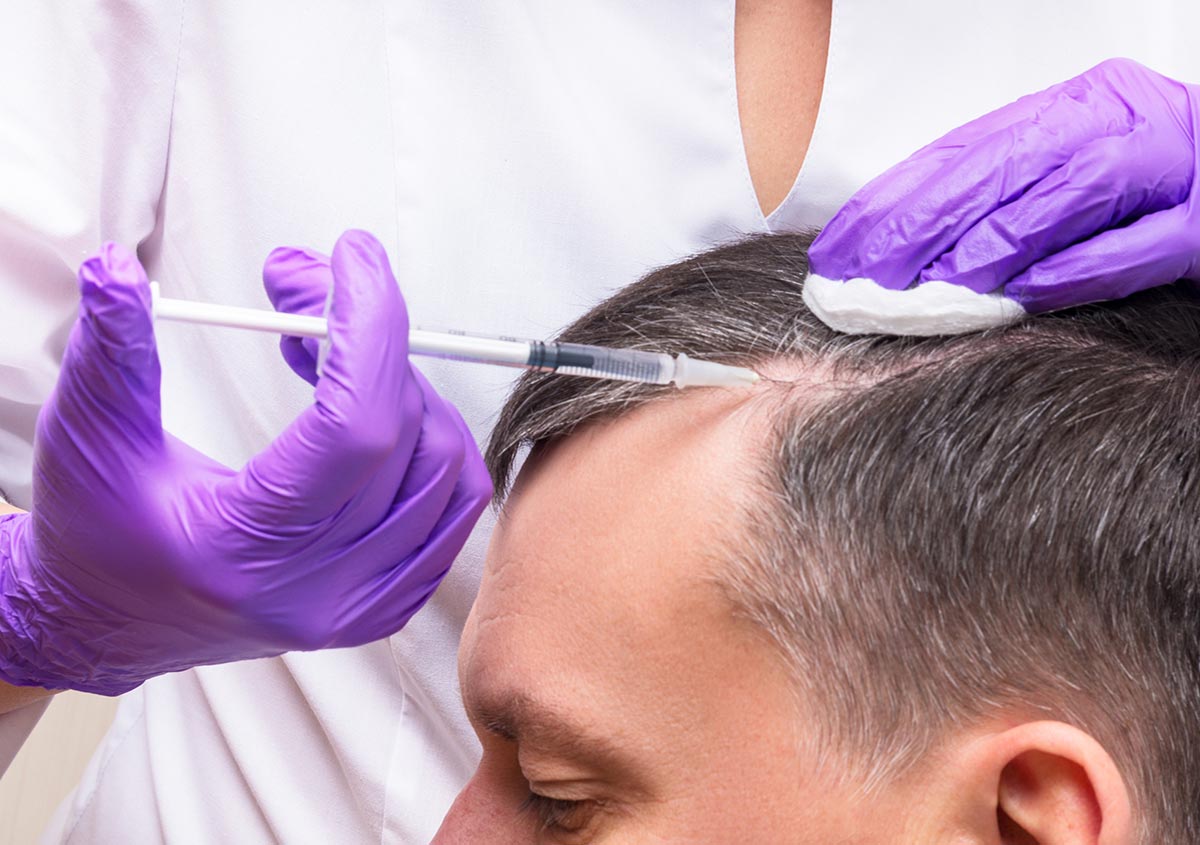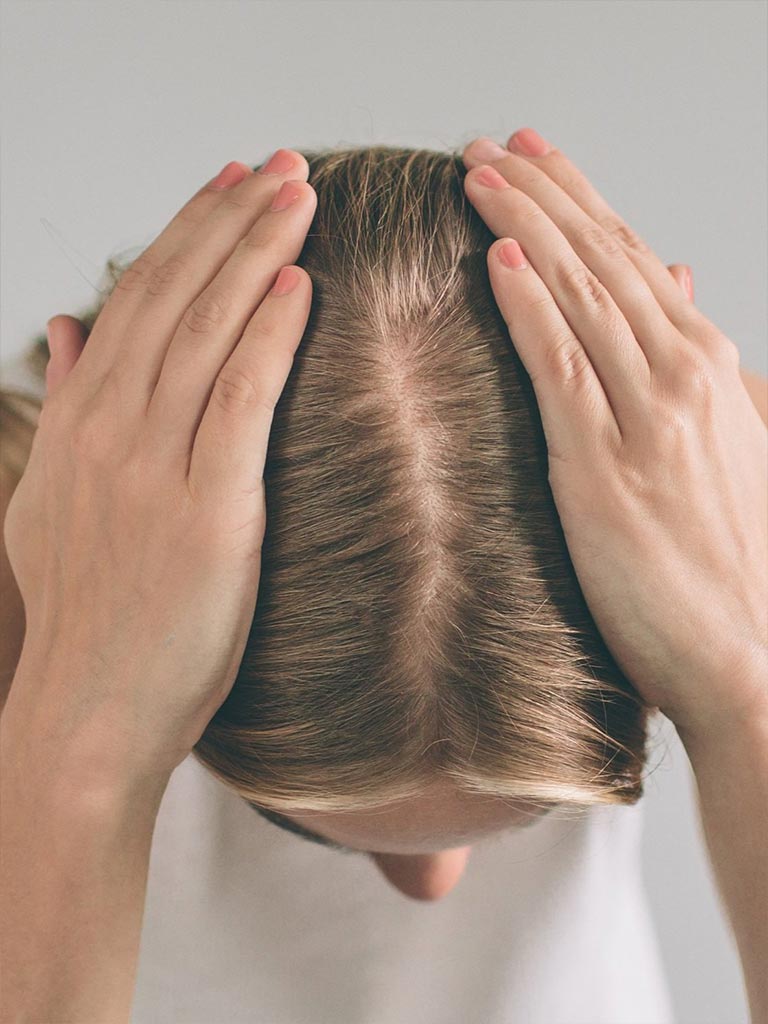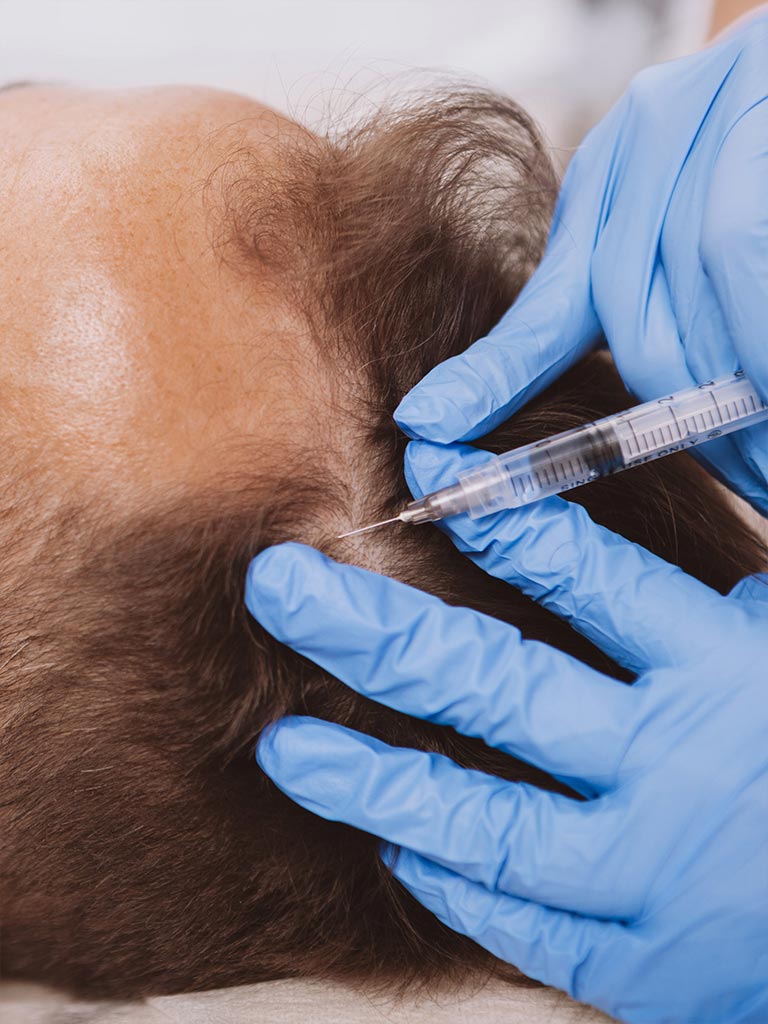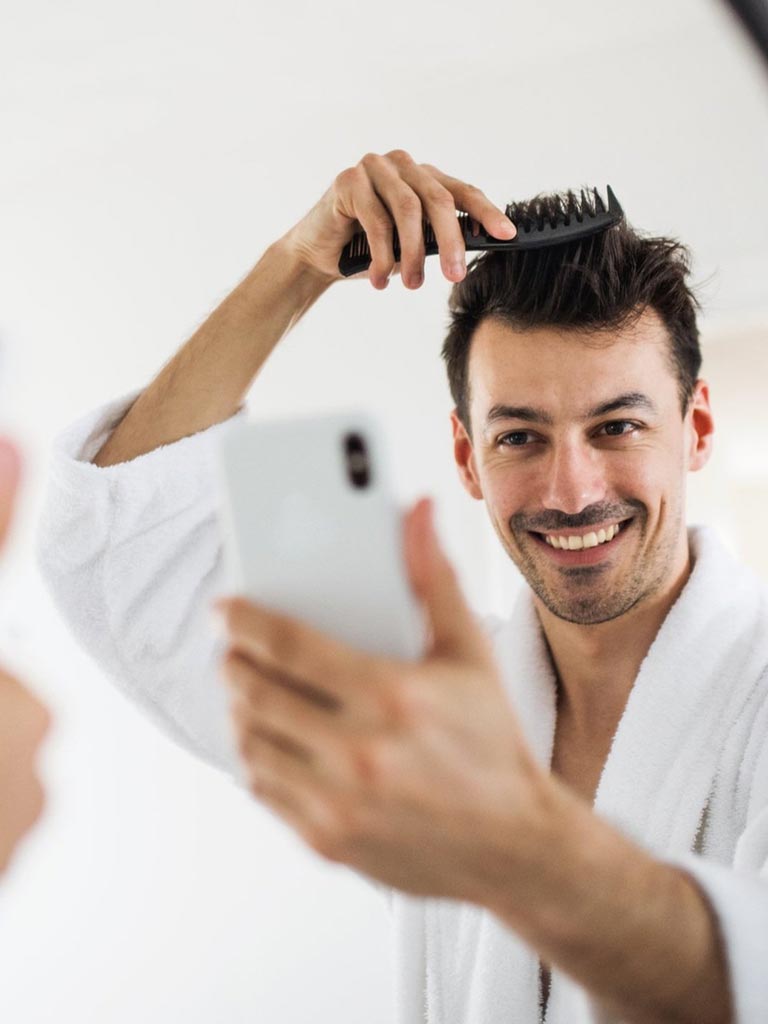
19
Jul
PRP Therapy: You’ve Heard the Buzz, Now Get the Facts

For many, hair loss is troubling and traumatic. Yes, those five million hairs on our body help insulate and protect us – but we tend to value the 100,000 hairs on our head above all. These strands are part of the “face” you present the world and are integral to the way you view yourself and are connected to your mental health. Their loss shouldn’t be taken lightly.
But hair loss is not a lost cause. PRP therapy may be the solution you are seeking.
The Lowdown On Hair Loss

A few strands in your brush or shower drain? That’s normal. People lose about 50 to 100 hairs a day as part of the growth and replacement cycle. But when you lose more than you’re replacing, it results in thinning and bald patches. We see:
- Androgenetic Alopecia: male- and female-pattern baldness
- Alopecia Areata: sudden, patchy hair loss
- Traction Alopecia: caused by hairstyles, such as braids and cornrows
- Frontal Fibrosing Alopecia: receding hairline
Depending on the type of hair loss, you may notice:
- Gradual thinning on top of the head
- Circular or patchy bald spots
- Sudden loss of your hair
- Full body hair loss
- Patches of scaling that spreads across your scalp
While some people prefer to let nature run its course, others cover hair loss with wigs, hats, scarves, and/or choose to pursue medical or cosmetic treatment.
Who Experiences Hair Loss?
While there are factors that increase the risk, hair loss can happen to anyone. Some of these are outside of our control – i.e. genetic, medical, hormonal, and age-related – but others we can mitigate with proper nutrition and wellness practices.
What Causes Hair Loss?
It’s a myth that hair loss comes from your mother’s side. Family history on one or both sides is the most common reason you’re seeing thinning and balding. Aging is second. Androgenetic alopecia impacts 80% of men and 50% of women.
Other causes of hair loss include:
- Medical conditions
- Hormonal changes
- Medications
- Excess stress
- Certain hairstyles and treatments (e.g. tight ponytails/braids, hot oil, etc.)
While you may not be able to control all the factors, you can take action!
When to See a Dermatologist
Persistent hair loss is distressing; it could also indicate a health issue that needs treatment. See your doctor if you notice sudden, patchy, or excessive hair loss. Consulting a dermatologist, alongside your primary care physician, is also key. A board-certified dermatologist can help you get to the root of the problem. Depending on the type of thinning you’re experiencing, a dermatologist can develop a targeted plan that may help with hair regrowth.
Introducing PRP Therapy

Platelet-Rich Plasma therapy unlocks the body’s natural regenerative power. These so-called “vampire” treatments use your own plasma to boost scalp circulation and stimulate regrowth. In just three to five sessions, many see dramatic results.
Platelets in the blood promote cell growth and regeneration. In PRP, the platelets are five times more concentrated than in regular blood. This allows them to reach the bottom of the hair follicle and stimulate derma papilla cells, an integral part of hair growth.
How Does PRP Therapy Work?
Don’t let the “vampire” of it all scare you! While PRP therapy does use your own platelets (and thus, your own blood), discomfort is minimal. After a quick needle in the arm, your blood is spun in a centrifuge to extract condensed platelet-rich plasma. This concentrated golden-yellow fluid is then injected into targeted areas of hair loss.
PRP treatments work best in the early stages of hair loss and for those with androgenetic alopecia. Book a consultation today to determine if you are a good candidate.
PRP Treatments: Benefits and Results
Hair loss impacts much more than your physical appearance. According to the National Institutes of Health, hair loss can lead to:
- Anxiety
- Depression
- Anger
- Embarrassment
- Lack of confidence
- Declines in work and sexual performance
- Social withdrawal
PRP therapy can help you get your life back. It is:
- Safe. By using your own platelets, you negate the risk of infections and adverse reactions. Some experience mild to moderate discomfort, but it is generally well-tolerated.
- Proven. PRP therapy is not new. It’s been used to treat sports and skeletal injuries, in maxillofacial surgeries, and to address skin care conditions – all with high success rates.
- Quick with minimal downtime. Depending on your hair loss and treatment plan, a session takes between 15 and 60 minutes. Afterward, you may feel minor redness or a sense of heaviness in the head, but these symptoms often disappear almost instantly. You can resume your normal day after treatment; just no shampooing or working out that day.
- Effective. This evidence-backed treatment delivers consistent results when used for hair loss. Research has shown it increases hair count, hair thickness, and the growth phase of the hair cycle.
PRP therapy has been referred to as “MiracleGro for the scalp” because it enhances the body’s own natural regenerative system and stimulates growth. For many experiencing genetic and male- and female-pattern hair loss, PRP is a true game-changer. If you are ready to change the game, book a consultation today.
The Science Behind PRP Therapy
None of us needs another snake oil treatment; you don’t need to spend hard-earned money on false promises. PRP therapy is proven – and well backed with scientific evidence of its efficacy. Scientists continue to explore its effectiveness for stress-related hair loss, alopecia areata, or scarring hair loss. However, patients with androgenetic hair loss are seeing lasting results. A systematic review of the research published in Aesthetic Plastic Surgery found that most studies confirmed reduced hair loss with increases in the diameter of hairs and density of regrowth.
Another study tested PRP therapy on men with androgenetic alopecia who had not had success after six months of oral medication. After four PRP treatments, their hair count increased by 30 percent.
Still, it is important to manage expectations. As Dr. Dianne Burrows offers, “PRP won’t bring back the head of hair you had in your teens and 20s! It can, however, offer a meaningful improvement. Patients need to be realistic about the outcomes, but not entirely without hope.” For millions, improvement looks, and feels, fantastic.

PRP Therapy Risks
When performed by a trained provider, PRP therapy is remarkably safe. There are some mild risks of which to be aware, including discomfort, redness, headache, occasional bruising, and temporary hair shedding. If you are a bit put off by needles, it can feel uncomfortable, but know that the pain is minimal and very short-lived. All of these potential side effects can be easily managed with cool air, ice packs, and acetaminophen.
The biggest “risk” involved is your own expectations. Again, as a sixty year old, you won’t see the head of hair you had in your twenties, but you may well see significant improvement. It is important to note that PRP is not a “one and done” therapy at this time, nor is it a cure. You need multiple treatments over a period of time to maintain your results (i.e. treatments every 3-6 months).
Paired Treatments
PRP is an integral part of a complete program to address hair loss. Depending on your needs, your plan may include treatments such as:
- RF Microneedling: This process Increases circulation which can enhance hair regrowth.
- Exosomes: There is emerging evidence that stem cell exosomes stimulate follicles and promote new growth. Stay tuned for expansion in this area!
- Topical Minoxidil: Most commonly known as Rogaine, this over-the-counter option revitalizes hair follicles, which promotes the growth of thicker, stronger hair. Clinical studies revealed almost 90% of men who used it daily for 4 months saw a reduction in hair loss!
For hair loss, there are medical treatments available. Medical treatments require a referral from your primary care physician and can include medications including oral minoxidil, finasteride, or spironolactone. When paired with PRP, medications can show enhanced efficacy.
What’s Next?
After a PRP treatment, you may feel a little discomfort but it is generally very well-tolerated. Address any concerns with your dermatologist. While you can go back to your everyday life without missing a beat, it is important to hold off on washing your hair for the rest of the day following your treatment and avoid working out. Be sure to follow all of your provider’s after-care recommendations for best results.
It is imperative that you follow your plan and receive follow-up treatments every three to six months (or as recommended by a board-certified dermatologist). This will help you maintain the results you have achieved. You can also take steps to care for your hair and, ideally, prevent other kinds of hair loss.
Busting PRP Therapy Myths

Believing PRP myths may prevent people from getting the help they crave. Let’s fight falsehoods with facts:
- I’m too young for this treatment. Hair loss doesn’t care about the date on your driver’s licence. In fact, people aged 24-45 are the most vulnerable to genetic and patterned hair loss. Early treatment is the most effective!
- PRP treatment is just for men. Don’t believe everything you see on the internet! Women suffer from hair loss as well, and just like men, they can benefit from PRP.
- It’s too expensive. Compared to home remedies and over-the-counter medications, PRP treatment is highly cost-effective. Many find the investment pays excellent returns when it comes to confidence and re-engaging with life.
- I’ll see results immediately. PRP doesn’t treat our need for instant gratification! It typically takes 3-6 months to stimulate and strengthen hair follicles and to see visible results.
Let’s get real:
- Genetics is the number one cause of hair loss. You cannot control who your parents (and their parents) are, but you can take action.
- You can reverse some types of hair loss. If your loss is due to poor nutrition, stress/anxiety, medical conditions, or hormonal imbalances, you may be able to control it as you address the underlying issue.
- It’s not caused by external and environmental factors. You are not losing hair because of the weather, because you wear a hat, or because you wash it a lot. You are losing hair because of internal triggers, like genetics, diet, hormones, and illness. Don’t blame yourself; help yourself.
- Proper diagnosis is critical. Once we understand what’s causing your hair loss, we can create a targeted treatment plan.
Is PRP Right for You?
Hair loss can be devastating but there are solutions. PRP therapy, administered by a board-certified dermatologist, can be effective in curbing loss and stimulating new growth – not to mention regaining your confidence. You want to feel more like yourself. Let us help.

Success Stories
Our patients consistently express their heartfelt appreciation for our services and team. We are deeply proud and genuinely delighted to serve such outstanding individuals, whom we cherish and care for as if they were our own family.
